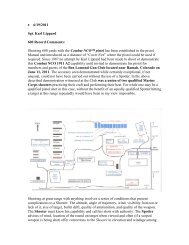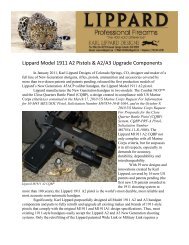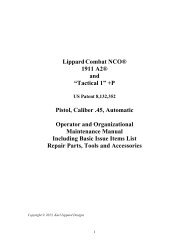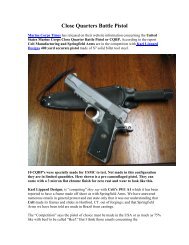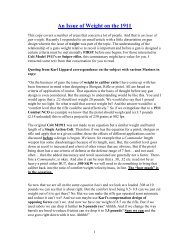Trigger Pull and the Truth About Sears - Karl Lippard
Trigger Pull and the Truth About Sears - Karl Lippard
Trigger Pull and the Truth About Sears - Karl Lippard
Create successful ePaper yourself
Turn your PDF publications into a flip-book with our unique Google optimized e-Paper software.
<strong>Trigger</strong> <strong>Pull</strong> <strong>and</strong> <strong>the</strong> <strong>Truth</strong> <strong>About</strong> <strong>Sears</strong><br />
<strong>Trigger</strong> pull, as you may know, is a troublesome issue on <strong>the</strong> 1911, <strong>and</strong> coupled with <strong>the</strong><br />
military need to have <strong>the</strong> pull weight at five pounds makes it even more so. Well, I think I<br />
have cured <strong>the</strong> problem - but first let’s examine what we know <strong>and</strong> <strong>the</strong>n get to <strong>the</strong><br />
solution.<br />
The Setup: The 1911 pistol was designed to go bang by John Browning. He shot at some<br />
rabbits in Utah <strong>and</strong> licensed it to Colt never to revisit <strong>the</strong> design again. The military in<br />
turn didn’t like a few things <strong>and</strong> subsequently requested Colt to alter <strong>the</strong> gun calling <strong>the</strong><br />
revision <strong>the</strong> 1911 A1. We go through various wars <strong>and</strong> nothing was ever really done<br />
again <strong>and</strong> some of <strong>the</strong> original mistakes are continued even today - specifically <strong>the</strong><br />
Hammer – <strong>the</strong> topic being discussed here.<br />
The trigger pull over <strong>the</strong> years remained <strong>the</strong> same <strong>and</strong> ranged from a minimum 5 pounds<br />
to a robust 6 ½. The sights were small to where you could hardly aim <strong>the</strong> pistols <strong>and</strong><br />
firing it was a major problem with a trigger that had creep, a hard break over <strong>and</strong> frankly<br />
didn’t want you to do it. So people started to; what’s ano<strong>the</strong>r word for dicking with it?<br />
Right, “Customize” <strong>the</strong> triggers <strong>and</strong> did “Jobs” on <strong>the</strong>m. Here is what a 1911 A1 basic<br />
Hammer <strong>and</strong> Sear engagement looks like.<br />
This is an NCO A2 model Sear on a model A1 Hammer. Pivot Sear, Hammer falls.<br />
Mil-Spec to memory is a 0.026 to 0.030” Sear ledge notch above.<br />
The Sear shares much of <strong>the</strong> same size as <strong>the</strong> ledge but had some dubious specifications<br />
on how to make <strong>the</strong> trigger pull “better.” Somebody was <strong>the</strong>refore always doing jobs on<br />
<strong>the</strong>m; “trigger jobs.” Here we find holes in <strong>the</strong> ceiling, guns going fully automatic,<br />
rounds through <strong>the</strong> leg <strong>and</strong> all manor of mayhem from jobs that just don’t work. The
iggest job done to <strong>the</strong> Hammer was to reduce <strong>the</strong> Sear Ledge depth to something under<br />
0.020” <strong>and</strong> it has long been considered anything under 0.018 was dangerous. But many<br />
gunmakers in <strong>the</strong> quest for a good trigger still do it <strong>and</strong> we see maker X in here all <strong>the</strong><br />
time with 0.014”!! Nice paint, pretty grips, outst<strong>and</strong>ing detail but stone cold deadly in <strong>the</strong><br />
h<strong>and</strong>s of <strong>the</strong> proud customer who carries it.<br />
So what <strong>the</strong>n CAN be done <strong>and</strong> stay within <strong>the</strong> original specifications?<br />
Well, you have to know what you are doing. The Sear edges can be radius as it says in<br />
<strong>the</strong> small print. The sharp edge of <strong>the</strong> Hammer ledge or notch can be touched to remove<br />
that. So far no harm. But our trigger is STILL 7 pounds!! And <strong>the</strong> pull begins in<br />
Georgia <strong>and</strong> doesn’t quit until <strong>the</strong> Communist Republic of California!! What??<br />
Well that’s <strong>the</strong> military specification <strong>and</strong> instruction of how to treat <strong>the</strong> parts.<br />
Comes now <strong>the</strong> “<strong>Trigger</strong> Job” artist. He weakens <strong>the</strong> Sear spring; he reduces <strong>the</strong><br />
tension on <strong>the</strong> disconnector, he cuts <strong>the</strong> Mains Spring, <strong>and</strong> he cuts <strong>the</strong> hammer ledge<br />
down to nothing. $500.00 later you have an Arkansas tooth pick that is equally<br />
dangerous in your pants. Did I say we are now in 2011?<br />
Well <strong>the</strong> first thing you need to do is put in a Combat NCO A2 Hammer that has a Sear<br />
Ledge of 0.022”. You match that with an A2 generation Sear made of S7 tool steel; you<br />
measure your Disconnector Spring tension of 1.5 to 2.0 pounds. You check <strong>the</strong> spring<br />
tension on <strong>the</strong> Hammer <strong>and</strong> see it is 2.5 pounds <strong>and</strong> if your surfaces are clean you are at 4<br />
pounds in math but due to angles of compression it will likely be 3.2 to 3.5 pounds, <strong>and</strong><br />
you can close <strong>the</strong> pistol up. What did it save you ? $450.00!!<br />
That is what SHOULD BE DONE, but not <strong>the</strong> WAY it is done today. You don’t know<br />
<strong>and</strong> your pocket is being picked.<br />
Now I have a 1.9 pound trigger pull on my NCO; I like it. I can shoot whatever is<br />
required however, but I am a tactical man that must be about his business <strong>and</strong> part of that<br />
requires some differences to <strong>the</strong> norm that is best discussed in <strong>the</strong> *Tactical Manual. But<br />
you can train yourself to use a clean trigger from 4.0 to 5.0 pounds easily <strong>and</strong> it will not<br />
go off when you holster it. A pretty trigger is 3.5 to 3.75 pounds as it will wear down<br />
with age <strong>and</strong> go to 3.2 in time….. But I just made a change in <strong>the</strong> Sear today.<br />
Comes now <strong>the</strong> new A3 Sear. It is from <strong>the</strong> A3 model NCO pistol. For those who want<br />
to jump technology to a safer <strong>and</strong> different feeling 4 pound trigger this is <strong>the</strong> one to buy.<br />
It does not fire like a conventional Sear design; a design that began with <strong>the</strong> bow <strong>and</strong><br />
arrow. In fact <strong>the</strong> Sear <strong>and</strong> Hammer ledge no longer have a part IN FIRING <strong>the</strong> gun but<br />
ra<strong>the</strong>r become instead ano<strong>the</strong>r form of Safety. This Sear fires from near its center of<br />
balance by <strong>the</strong> principle of Anvil <strong>and</strong> Fulcrum.<br />
Let’s view it here. Pretty isn’t it?
New patented A3 Sear <strong>and</strong> A3 Hammer. After 7000 years here <strong>the</strong>y are!!<br />
Yes she is pretty this Sear; <strong>the</strong> Hammer too. As you compare it to <strong>the</strong> A2 picture fur<strong>the</strong>r<br />
up <strong>the</strong> page <strong>the</strong>re is some features on <strong>the</strong> Hammer that are different, <strong>and</strong> we speak to<br />
those “Swim” features in <strong>the</strong> NCO & CQBP Manuals, but note if you will <strong>the</strong> cleft at<br />
<strong>the</strong> bottom were a protrusion of <strong>the</strong> Sear seems to interface or engage <strong>the</strong> Hammer to a<br />
point; something not done before. The Sear <strong>and</strong> Hammer ledge seems <strong>the</strong> same as before<br />
<strong>and</strong> <strong>the</strong>y are. So what is this business? What is happening here?
What you are seeing is a <strong>the</strong>ory change in <strong>the</strong> firing a weapon or triggering a device. The<br />
1911 Sear pivots on a center pin. An equal length provides equal travel <strong>and</strong> pressure on<br />
both ends. If we shorten one side <strong>the</strong> pressure required would be less but <strong>the</strong> travel<br />
required on <strong>the</strong> o<strong>the</strong>r side of <strong>the</strong> Anvil would be greater <strong>and</strong> visa versa.<br />
Therefore ra<strong>the</strong>r than change to equal balance of present sear movement as it relates to<br />
hammer engagement or existing pressure of Hammer spring, or its diameter geometry -<br />
we simply “trick” <strong>the</strong> existing process to do something else. We introduce a new point of<br />
leverage fur<strong>the</strong>r down on <strong>the</strong> Sear, produce a new radius for action on <strong>the</strong> Hammer, <strong>and</strong><br />
change <strong>the</strong> way <strong>the</strong> Sear trips as a trigger device to a New <strong>Karl</strong> <strong>Lippard</strong> system called <strong>the</strong><br />
A3; A new system design that can be applied to all such mechanism types without a<br />
material design change or added internal space requirement. This adds additional safety<br />
to <strong>the</strong> firearm as <strong>the</strong> Sear /Hammer ledge is rendered now as a point of rest, not a trip or<br />
firing ledge.<br />
In doing this we also change <strong>the</strong> way a trigger feels when “pulled” in a way not<br />
experienced before. The drag of <strong>the</strong> sear face over <strong>the</strong> Hammer ledge is no longer<br />
present. We are momentarily elevating <strong>the</strong> Hammer by rotation of <strong>the</strong> Sear that when<br />
offered rest again it resides in air, thus falls without a body of support to rest on.<br />
<strong>Trigger</strong> pull length is not changed. The distance of leverage remains equal but <strong>the</strong> point<br />
of action has changed. Thus any firing mechanism of <strong>the</strong> future need not consider a<br />
trigger point as a point of equal force but ra<strong>the</strong>r where to place <strong>the</strong> action of force to<br />
release its point of connection.<br />
We see <strong>the</strong> “trigger job” now has left <strong>the</strong> building. The 0.014” dangerous ledge reduction<br />
is gone. The danger presented by trigger tampering is gone too <strong>and</strong> <strong>the</strong> fine trigger we<br />
were looking for now is just a selection of trigger pull weight engraved on its side.<br />
This one shown in picture on <strong>the</strong> reverse side is a #4 or four pound trigger pull. In work<br />
now are 3, <strong>and</strong> 3 ½ pull weights for testing. You just read <strong>the</strong> weight on <strong>the</strong> Sear, drop it<br />
in, <strong>and</strong> close <strong>the</strong> pistol up. True you must have an A3 NCO Hammer for <strong>the</strong> A3 Sear to<br />
work; you must buy both. But <strong>the</strong> experience is not to be believed. You pull <strong>the</strong> trigger<br />
<strong>and</strong> <strong>the</strong>re is no creep, no load up, no sharp fall; it’s a clean pull like a 4 pound pillow that<br />
feels like 3 ¼, <strong>and</strong> <strong>the</strong> Hammer…it just FALLS! You cannot tell you are pulling against<br />
anything. The gun just fires!!<br />
This design makes safe all firearms, machineguns, <strong>and</strong> devices with a trigger <strong>and</strong> a<br />
hammer ledge design down to bow <strong>and</strong> arrow set triggers; spinning reels <strong>and</strong> crane
cable releases. You can have a 20 pound trigger sear to hammer engagement <strong>and</strong> a<br />
release weight of choice. WOW!!!<br />
You have to PULL THIS TRIGGER TO GO OFF!!! It will NOT JAR OFF!!!<br />
So what does it take to Upgrade your 1911??<br />
Well you can buy an A2 Sear to fit your A1 Hammer. Fix that problem if someone has<br />
messed with that.<br />
You can buy an A3 Hammer that is not made dangerous <strong>and</strong> with no assistance you can<br />
have a good safe trigger in <strong>the</strong> 4-5 pound range h<strong>and</strong>s off.<br />
Or, you can step up to <strong>the</strong> new world of Safe Pistol improvement by installing a A3<br />
Sear to match <strong>the</strong> A3 Hammer, do nothing <strong>and</strong> with a #4 close <strong>the</strong> gun up without<br />
touching a thing but a swap of components.<br />
The A3 Sear is <strong>the</strong> most significant change in design for <strong>the</strong> last 7,000 years. The safest<br />
Sear ever made by man.<br />
Welcome to <strong>the</strong> world of <strong>Karl</strong> <strong>Lippard</strong> Designs. I hope this education proves useful to<br />
you.<br />
<strong>Karl</strong> <strong>Lippard</strong><br />
*Tactical Manual is not available to <strong>the</strong> public for consumption.*



